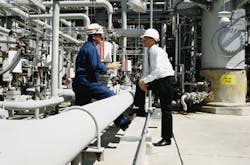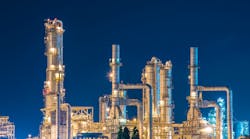Eric J. van Gemeren is currently the Vice President of R&D for Flowserve Corporation and is responsible for the worldwide development of new products and technologies for the company”s fluid motion control product line. Mr. van Gemeren has overall accountability for managing Flowserve’s global portfolio of investments in emerging technologies that are applied across the entire product range. He can be reached at [email protected].
Q: In light of the global recession, how has the valve industry faired compared to other industrial equipment sectors over the last five years?
A: The impact of the recession lingers. For the wealthy nations of the Organization for Economic Cooperation and Development (OECD), economic recovery continues to be a slow process, with annual gross domestic product (GDP) growth rates of 2 percent or less impeding a return to prosperity. Even the progress of the emerging non-OECD countries has been dampened. The white-hot economies of China and India have seen their GDPs slow from annual growth rates of more than 10.5 percent to 8.5 percent. Yet, signs of renewed prosperity are increasingly evident and are being seen in unexpected places.
Energy moves the world and its economies. The emergence of technologies to exploit unconventional oil and gas—oil sands, shale gas, deep-water oil and shale oil—is creating a sea change within the global energy, hydrocarbon processing, petrochemical/chemical, and power industries. According to some reports, more than half of the international oil companies’ long-term capital investments are now going into these unconventionals. Analysts have identified a significant westward shift in oil industry investment, away from traditional areas like North Africa and the Middle East and toward the Brazilian offshore, deep water oil in the Gulf of Mexico and West Africa, as well as unconventional oil and gas in North America. Not to mention Australia’s immense natural gas reserves which are in the early stages of a spectacular growth phase.
So how is all this impacting the valve industry? Along with other industrial equipment and components manufacturers, conglomerates, and industrial electric equipment companies, valve makers were negatively affected by the economic downturn during 2008–2009. OECD market economies declined by 4 percent in 2009 after being essentially flat the previous year. Emerging economies were not immune from the global economic situation, although their aggregate GDP growth rates remained enviable. While some industrial equipment manufacturers weathered the headwinds with marginal impact, most were significantly affected in terms of revenue and operating income.
As a whole, valve manufacturers’ revenue growth rates have generally tracked with other industrial segments on a year-to-year basis from 2008 through 2011, albeit with stronger cyclicality. In terms of operating income, the valve and industrial equipment and components markets have not recovered as effectively as the aforementioned comparative segments, reflecting a choppy and slow pace of the recessionary recovery.
Q: What are some growth areas or opportunities you see for valve manufacturing over the next few years?
Image courtesy of Flowserve Corporation
A: Traditionally, valve manufacturers and others have segmented the market into OECD and non-OECD or emerging market components. This delineation has remained valid, but the dynamic has changed. The former continues to emphasize efficiency through de-bottlenecking, asset life extension, maintenance, and MRO. The latter continues its focus on massive infrastructure projects as it moves rapidly to fulfill the consumption desires of its people. But the explosive growth in natural gas production from shale rock and tight oil from dense rocks—both made possible by the combination of hydraulic fracturing and horizontal drilling technologies—has become a game changer.
In the U.S., shale-gas production with its associated condensates is spurring the construction of plants that make chemicals, plastics, fertilizers, steel and other products. A conceptual study for a U.S. $10 billion gas-to-liquids (GTL) plant has commenced that will convert natural gas to diesel fuel. Proposed liquefied natural gas (LNG) import terminals are being repurposed to add to the country’s export business. The European Union (EU) is expecting similar results from its vast shale resources, especially those in Poland. Most significantly Australia is awash in natural gas reserves for export to Japan, South Korea and China. In the down-stream segments, a river of capital continues to flow to projects in the Middle East and Asia-Pacific. The scale and capacity of these plants are enormous compared with existing hydrocarbon processing facilities, creating a tremendous opportunity for valve makers that can service this market.
Q: What are the biggest challenges facing valve manufacturing and technology today? How do you believe those challenges will be overcome?
A: In a sense, the rising and falling tides of the global economy may be the least of the obstacles facing the valve industry, as business managers are well practiced in responding to these exigencies. Ironically, the greatest challenges within the industry are a direct result of the opportunities previously discussed. For example, of the 62 refineries to be built in non-OECD countries over the next decade, many will produce an average of 370 000 barrels/day or more of finished and intermediate products, nearly twice the output of typical existing refineries. These larger plants are requiring larger scale equipment. Heretofore, "large" 300 mm (12 in) to 400 mm (16 in) valves are now being routinely specified as 600 mm (24 in) to 900 mm (36 in). Not only are the valves larger, but the pressure and temperature requirements are increasing, thereby requiring higher, more exotic alloys. This is putting an immense strain on valve manufacturers’ supply chains, as well as severely stretching their engineering, manufacturing and application testing capabilities.
But this is only one of several obstacles facing the valve industry. A more basic and perhaps more critical challenge confronting the OECD and non-OECD segments alike is the steady decrease of engineering and applications expertise throughout the valve industry—from the manufacturer to the contractor and at the end user’s plant. This certainly affects the accurate sizing, selection, and application of valve technology, but it also extends into the maintenance sheds where fewer technicians have the requisite experience and skills to properly maintain valving and actuation equipment. The obvious solution is the training of a new cadre of flow control engineers and technicians to specify and maintain equipment, but this is not a wholly practical one given the pace of infrastructure expansion. Instead, valve manufacturers must respond with specialized software and programs, allowing users of valve technology to correctly and effectively apply and specify equipment despite their inexperience. In addition, end-users will need to grow more comfortable with outsourcing a greater share of their maintenance workload to the valve OEM.
The burgeoning economies of the non-OECD countries will continue to expand at a historically high, if temporarily reduced, pace. Their requirement for larger size equipment with higher performance ratings is posing significant engineering, design, production, and supply chain hurdles that will require extraordinary expertise and a good deal of innovation. Unconventional oil and gas has resuscitated the moribund energy sectors of several OECD countries with the potential to significantly shift the balance of supply while breathing new life into their process industries.
Q: What do you see as the most important technology and application trends impacting the valve segment today?
A: We have talked about application trends toward bigger sizes, temperature and pressure requirements, and the increasing dependence on valve manufacturers’ expertise. In addition, digital technology is also having an increasingly profound effect on process control, quality control, maintenance activities, and associated costs. Digital fieldbus technologies are finally delivering on the promise of greater efficiency in process plant applications. A digital fieldbus output can drive a valve to its desired position and inform the control system if the requested position and valve performance have been attained. Only then can closed-loop digital control become feasible. Recent innovations have added and enhanced several internal variables within the positioner, such as speed of response, position and pressure to form multiple internal diagnostics within valves. Advances in field device tool (FDT) and device type manager (DTM) technologies have provided a standardized user interface between host systems and field devices. DTM software continuously captures rich diagnostic data from the valve, actuator, positioner, and control signal while the process is running, and it allows display of this data in an intuitive graphical user interface.
An open-standards communications system with its inherent flexibility is key, as it tends to create more value for the end-user than a proprietary communication system. With an open-standards communications system, the user is free to include the full range of digital networking technology, resulting in tighter, more effective system integration. This enables the user to be more highly aware of actual field operating phenomena along with the diagnostic capabilities for corrective action. The integrated digital control network can further compensate for the shortage of qualified process and application expertise by increasing process uptime, minimizing maintenance workload, reducing feedstock consumption, and improving end-product quality. Additionally, equipment setup, troubleshooting, and reliability are enhanced due to the FDT and DTM maintenance tools with their advanced field diagnostics.
Q: How do you see the valve manufacturing industry moving ahead in the next 5-10 years?
A: For valve manufacturers, the opportunities are great, the challenges many. Their success will be dependent upon investment in innovation—and not just product innovation. Growth will manifest itself through creative solutions to the biggest problems facing customers today as discussed above: increasing scope/scale of new plant construction and more challenging process conditions; the loss of technical talent; the need to provide more cost-effective and efficient on-site support in emerging economies; and the need to embrace open-standards for digital integration and asset management. In short, the industry is ripe for new thinking from outside itself.




